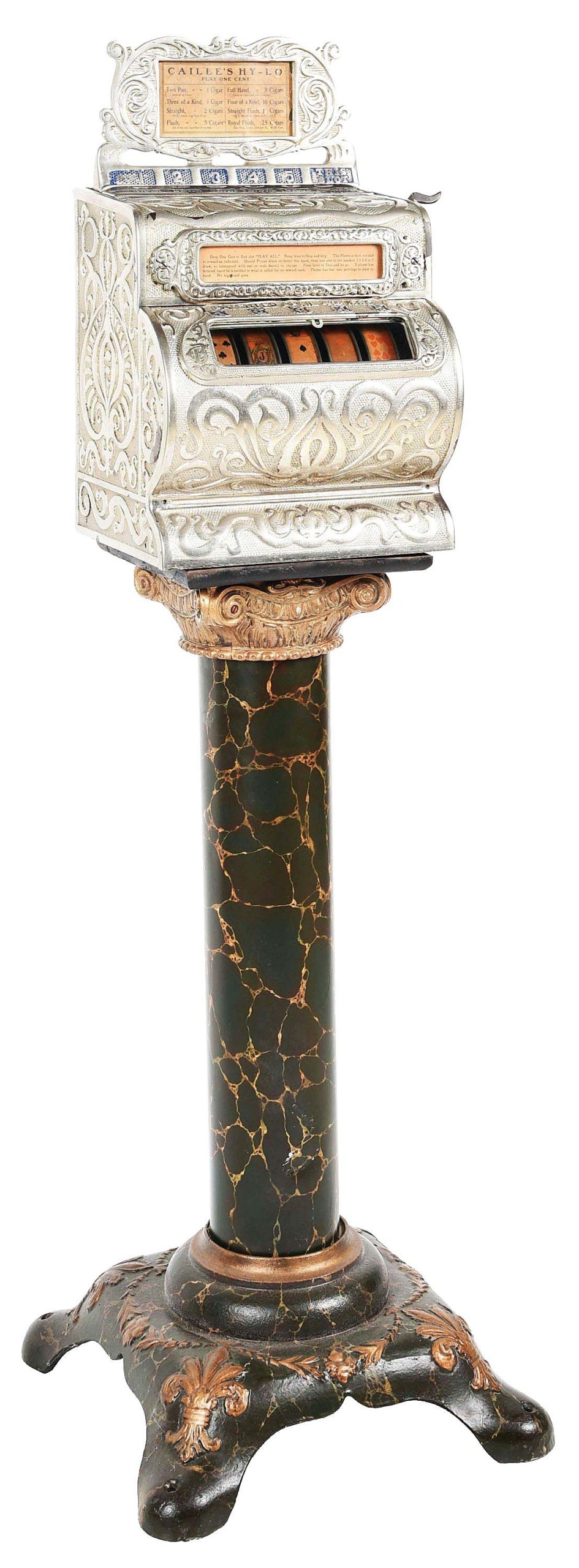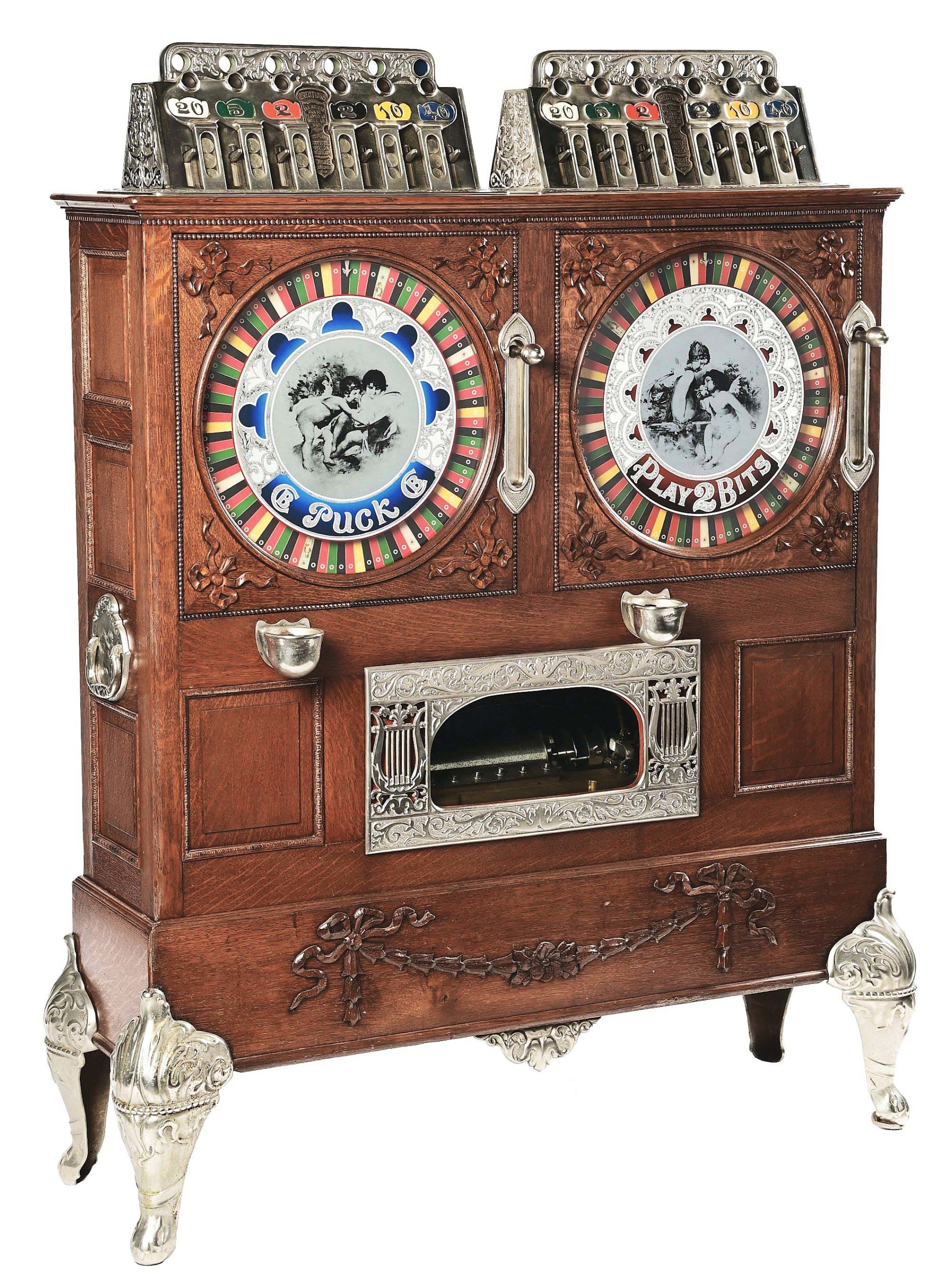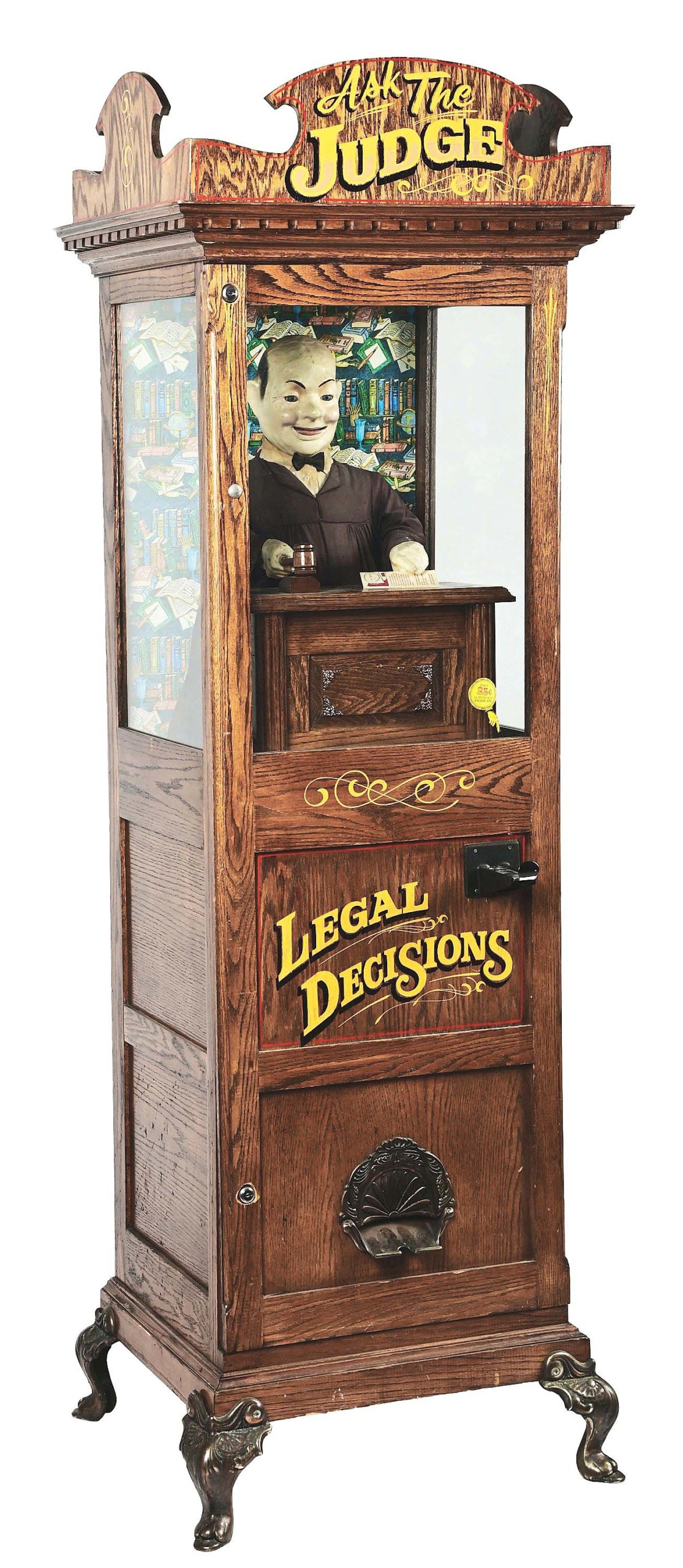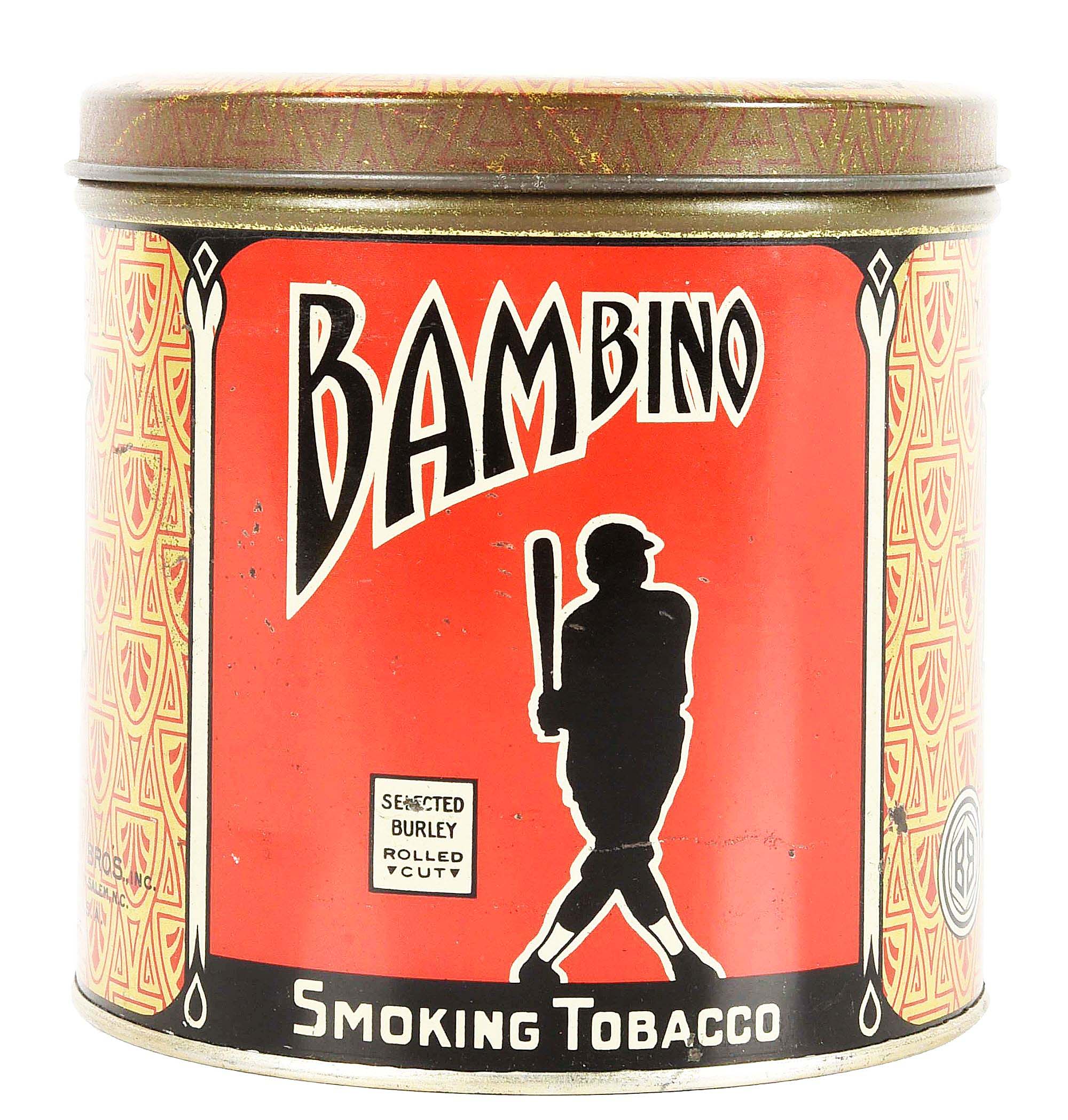
Original circa 1904 Mills 1¢ novelty “Hats Off” penny arcade lung tester with faces of eight different men whose tin (designed to replicate “straw”) hats can be blown off if user’s lung strength is sufficient. Message on front panel says “Come On Boys…Who Blows Best.” Extremely rare; one of fewer than a handful known. Sold well above high estimate for $119,000.
LAS VEGAS — Morphy Auctions has returned to Vegas, and West Coast collectors are loving it. After a four-year hiatus, the Pennsylvania company’s $5.1 million sale conducted at its new Vegas location on October 27-30 was the first step toward reestablishing Morphy’s presence in America’s entertainment capital. Motivated bidders, including many who have been loyal Morphy Auctions customers for years, came from literally all Western states to attend the 2,214-lot sale of premium-quality coin-op and gambling machines, antique advertising and country store treasures.
“It was so refreshing to see so many old and new friends in attendance, and the energy and excitement of the sale went beyond anything witnessed since pre-Covid. With a profound exclamation point, it’s rewarding to simply say, we’re back!” said auction curator Tom Tolworthy.
Those in attendance gave an enthusiastic thumbs up to Tolworthy’s confirmation that, going forward, the spacious new Las Vegas facility will serve as the permanent venue for all of Morphy’s popular coin-op and antique advertising sales. But that’s not all. In recognition of the West Coast’s dynamic car culture, a February 24-25 automobilia and petroliana auction has been added to the company’s Las Vegas calendar.

Circa 1902 Caille 1¢ Hy-Lo cast iron “draw poker” cigar trade stimulator with ornate decoration. Rare and in untouched, all-original condition, including the marquee and paper award card. Fresh to the market from a 30-year private collection, it sold for $60,000, its high estimate.
The spectacular coin-ops that awaited bidders at the October sale formed a visual history of machines whose original purpose was to entertain, dispense goods or offer patrons the chance to hit a jackpot, all for the cost of a coin. More than 15 coveted upright slot machines highlighted the offering, including several early rarities manufactured by Caille Bros of Detroit, Mich.
A circa 1903 Caille 5¢ and 25¢ double musical Puck upright slot machine displayed not only mechanical ingenuity but also great decorative beauty with its colorful gaming wheels set behind two cherub decals. Complete with a rare, interchangeable cylinder music box, it sold above its high estimate for $74,400.
Another top seller was the circa 1910 Caille “Tourist” cast iron slot machine. Tolworthy observed that this particular model is “unique among the single-reelers produced in the early Twentieth Century.” The player would choose a country from the list provided, deposit a nickel and pull the handle. If the chosen country appeared after the handle was activated, the machine would pay out accordingly. In wonderful overall condition with an attractive natural patina, it sold within estimate for $66,000.

Circa 1903 Caille Bros. 5¢ and 25¢ double musical Puck upright slot machine. Very early model with colorful gaming wheels set behind two cherub decals. Complete with rare interchangeable cylinder music box. It sold above high estimate for $74,400.
Caille’s versatility and awareness of its competition led to the manufacture of its circa 1902 Hy-Lo 1-cent cast iron “draw poker” cigar trade stimulator. This ornate design was Caille’s answer to Mills’ “Hy-Lo,” but today, the Caille machine is far more rare. In untouched, all-original condition, including the regal scrolled marquee and paper award card, the example offered by Morphy’s was absolutely fresh to the market, having come directly from a 30-year-collection. It achieved its exact auction high estimate of $60,000.
Bidding paddles were airborne for one particular arcade machine, an original circa 1904 Mills 1¢ novelty “Hats Off” lung tester. Its design incorporated the faces of eight different-looking men whose tin (designed to replicate “straw”) hats could be blown off if a user’s lung strength was sufficient. A message on its front panel enticed potential players with the message “Come On Boys…Who Blows Best.” One of fewer than a handful known, the machine sold well above high estimate for a powerful $119,000.
Several fortune tellers were on hand to predict the future. A later production, a circa 1970 floor model machine known as “Ask the Judge” was designed to accept quarters. Upon the deposit of a 25¢ coin, the judge raises his gavel, speaks his decision, then issues a card with jokes on it. The machine’s manufacturer is unknown, but its nice condition suggested it might never have actually been placed at an arcade or elsewhere. It sold for $22,800 against an estimate of $1/3,000 — a price that Morphy’s didn’t predict, but maybe the judge did.

Circa 1970 floor model 25¢ “Ask the Judge” fortune teller machine. Judge raises gavel, speaks his decision, then issues a card with jokes on it. Manufacturer unknown, VG condition suggests it was never installed for use at an arcade or elsewhere. It sold for $22,800 against an estimate of $1/3,000.
There’s never a shortage of interest in fine, early breweriana, as reflected in the prices for two handsome pre-Prohibition signs. A scarce eight-color porcelain corner sign advertising Excelsior Brewery of Buffalo, N.Y., presented in clean 8.5 condition and was described in the catalog as “the better of only two known examples.” It doubled its high estimate at $44,280. The second notable entry, a circa 1910s “Jackson Brewing Co Beer San Francisco” reverse-painted on glass sign with the image of Andrew Jackson rose to $36,900 against an estimate of $3/6,000.
The pursuit of neon automotive dealership signs only continues to grow. At the October sale, a rare and outstanding Chevrolet Art Deco single-sided porcelain neon sign with a Telechron clock sold above estimate for $98,400, while a circa 1930s Oldsmobile single-sided porcelain neon sign, also with Art Deco styling, brushed its high estimate at $49,200.
An advanced collection of more than 150 antique occupational shaving mugs crossed the auction block, boasting some of the finest examples ever to appear at auction. The mugs attracted intense bidding and chalked up extraordinary prices. The top seller was a mug dated “1924” with the image of a policeman riding on a motorcycle. It raced to a $30,000 finish against an estimate of $1/1,500.

Rare “Bambino” tin tobacco canister with graphics depicting the silhouette of a baseball player. Possibly the only extant example of its type. Strong 9.0 condition. It sold for $25,830 against an estimate of $5/15,000.
Also worthy of note was an extremely rare “Bambino” tin tobacco canister with appealing graphics depicting a baseball player in silhouette. In 9.0 condition and possibly the only one of its type in circulation, the tin knocked it out of the park, commanding $25,830 against an estimate of $5/15,000.
Prices given include the buyer’s premium as stated by the auction house. For information, www.morphyauctions.com or 877-968-8880.














